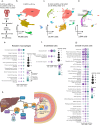This is a preprint.
Elevated apolipoprotein C3 heightens atherosclerosis risk by mediating arterial accumulation of free cholesterol and local inflammation in diabetes
- PMID: 40709279
- PMCID: PMC12288534
- DOI: 10.21203/rs.3.rs-6979508/v1
Elevated apolipoprotein C3 heightens atherosclerosis risk by mediating arterial accumulation of free cholesterol and local inflammation in diabetes
Abstract
Cardiovascular outcome trials are being considered for therapeutics that silence apolipoprotein C3 (APOC3) or angiopoietin-like 3 (ANGPTL3) because of their abilities to lower triglyceride-rich lipoproteins (TRLs) and their remnants in individuals with increased cardiovascular disease (CVD) risk1-4. Here we demonstrate that plasma APOC3 predicts CVD events in individuals with diabetes more strongly than in those without diabetes. Accordingly, plasma APOC3 levels are elevated, clearance of TRLs/remnants is slowed, and plasma TRL remnants are increased in two mouse models of diabetes-accelerated atherosclerosis. Silencing mouse APOC3 by a liver-targeted antisense oligonucleotide lowers both cholesterol and triglycerides carried by TRL/remnants and LDL and prevents aortic free cholesterol accumulation in diabetes, while ANGPTL3 silencing reduces triglycerides. Single-cell RNA-sequencing revealed that APOC3 silencing prevents a majority of diabetes-induced pathways in macrophages, endothelial cells, and smooth muscle cells, with inflammation as a major predicted upstream regulator, adding promise to APOC3 as a CVD target in diabetes.
Conflict of interest statement
Competing interest. A.E.M. is employed by Ionis Pharmaceuticals. K.E.B. serves on the scientific advisory board of Esperion Therapeutics, Inc.
Figures



Similar articles
-
A novel mouse model of familial combined hyperlipidemia and atherosclerosis.Acta Pharmacol Sin. 2024 Jun;45(6):1316-1320. doi: 10.1038/s41401-024-01241-8. Epub 2024 Mar 8. Acta Pharmacol Sin. 2024. PMID: 38459255 Free PMC article.
-
Olezarsen for Hypertriglyceridemia in Patients at High Cardiovascular Risk.N Engl J Med. 2024 May 16;390(19):1770-1780. doi: 10.1056/NEJMoa2402309. Epub 2024 Apr 7. N Engl J Med. 2024. PMID: 38587249 Clinical Trial.
-
Effects of Evolocumab on the Postprandial Kinetics of Apo (Apolipoprotein) B100- and B48-Containing Lipoproteins in Subjects With Type 2 Diabetes.Arterioscler Thromb Vasc Biol. 2021 Feb;41(2):962-975. doi: 10.1161/ATVBAHA.120.315446. Epub 2020 Dec 24. Arterioscler Thromb Vasc Biol. 2021. PMID: 33356392 Clinical Trial.
-
The Black Book of Psychotropic Dosing and Monitoring.Psychopharmacol Bull. 2024 Jul 8;54(3):8-59. Psychopharmacol Bull. 2024. PMID: 38993656 Free PMC article. Review.
-
Quality improvement strategies for diabetes care: Effects on outcomes for adults living with diabetes.Cochrane Database Syst Rev. 2023 May 31;5(5):CD014513. doi: 10.1002/14651858.CD014513. Cochrane Database Syst Rev. 2023. PMID: 37254718 Free PMC article.
References
-
- Bergmark B.A., et al. Olezarsen for Hypertriglyceridemia in Patients at High Cardiovascular Risk. N Engl J Med 390, 1770–1780 (2024). - PubMed
-
- Ballantyne C.M., et al. Plozasiran, an RNA Interference Agent Targeting APOC3, for Mixed Hyperlipidemia. N Engl J Med 391, 899–912 (2024). - PubMed
-
- Ballantyne C.M., et al. Effect of Targeting apoC-III with Plozasiran on Lipoprotein Particle Size and Number in Hypertriglyceridemia. J Am Coll Cardiol (2025). - PubMed
-
- Rosenson R.S., et al. Zodasiran, an RNAi Therapeutic Targeting ANGPTL3, for Mixed Hyperlipidemia. N Engl J Med 391, 913–925 (2024). - PubMed
Publication types
Grants and funding
LinkOut - more resources
Full Text Sources
Miscellaneous

